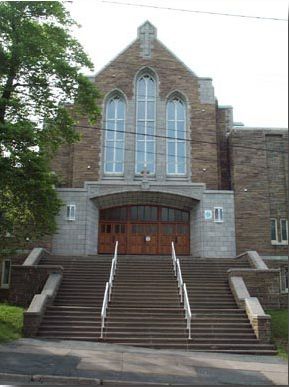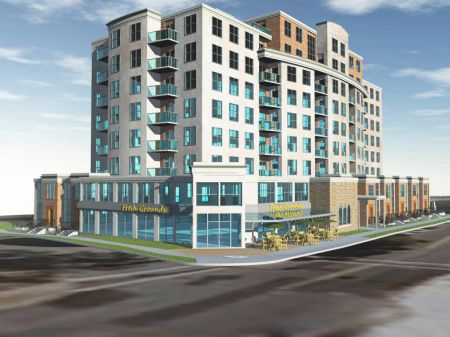The conversion of a former Halifax church site into a condominium building is dividing a North End community.
St. Joseph’s Church once stood on the square formed by the intersection of Gottingen, Kaye and Russell Streets. Developers ECL General Partner IV Limited, a subdivision of Sobeys Incorporated, are looking to erect a nine-storey mixed residential and commercial building in its place.
The property was sold to ECL in March 2008 in an agreement with the Roman Catholic Episcopal Corporation.
The grounds were not purchased at a fixed amount, explains the Archdiocese of Halifax Financial Administrator Peter Browne: “Our value is somewhat dependent on what they build,” he says. “So, if they have more density, we do get more money.”
“We” meaning the parish, one that desperately needs a financial injection.
St. Joseph’s Church was closed in June 2006 due to structural damage, a dwindling congregation, and a lack of funds to maintain the building. It was then amalgamated with St. Stephen’s Church to form the Blessed Mother Teresa Parish.
The merger struck a hard blow to the St. Joseph’s congregation: “That was my church. My daughter crawled around the floor of that church,” says longtime member Craig Berryman. “Nobody wanted it [the closure] to happen but sometimes things happen that you don’t want to.”
Following the parishes’ amalgamation, a Property Transition Committee was struck to decide the best use for the property. Browne explains a request for proposals was sent out. The Committee’s hope was that the building could be reconstituted in some way to provide the parish with a steady income.
The idea was not appealing to developers. Enter ECL.
“We wanted to be responsible in that neighbourhood,” says the archdiocese Communications Officer Marilyn Sweet. She describes ECL as “good citizens” and “responsible” with regards to their other developments. The idea of condominiums attracting more families to the area was also appealing to the church, as was the company’s promise of incorporating some of the church’s artifacts into the new structure.
But some community members see the development in a completely different light: “They’re going ahead with a monstrous building [that is] in our view totally out of character with the neighbourhood,” says Robert McKillip of his and his wife’s opinion of the plan.
The McKillips are residents of Russell Street, which runs from Robie to Barrington Streets. It is relatively quiet and sparsely filled with low-rise residential, commercial and a few industrial units. The number of buildings that towered above the St. Joseph’s Church steeple could be counted on one hand.
McKillip is adamant that neither he nor his wife is against urban development. They supported a condominium project that was erected by another developer across the street from their home.
But he sees ECL as a company that has done little to consider the needs and desires of people living in the vicinity of the church. He voiced this opinion at a public information meeting held on Apr. 28, 2010. He was one of several community members who outlined their concerns with the project, from its height and lack of green spaces, to its effect on traffic and shade.
ECL conducted all the studies of the proposed building, causing some community members to question whether the draft project was being analyzed in the best interest of the entire community or solely that of the buyer and seller.
ECL did not respond to repeated attempts to contact them regarding this project.
The development project required an amendment to the Municipal Planning Strategy (MPS) for the rezoning of the site from Park and Institutional Designation to mixed-use residential and commercial. Such a transformation is very rare and requires “community acceptance” according to a City staff report. The amendment was approved Sept. 27 of this year.
The City also made an exception concerning the density of the proposed condominium building: the total possible population was increased to 200 from 148.
McKillip sees these modifications to MPS as a bias toward the developers. He also thinks the financial interests of the archdiocese make its representatives more willing to vote in favour of the project: “Sobeys is using its money, part of the potential profits of the development of the property, to bring on side a part of the community, which [it] splits off from the rest of them.”
“If you think those people in the parish are coming forward just because they’re going to get an extra couple of dollars and saying, ‘We like it,’ I don’t think that’s happening,” Browne counters.
McKillip couldn’t disagree more: “I believe they wouldn’t be having private meeting with the developers and the parish trying to exclude all the other people from it…they wouldn’t be hiding something if they didn’t think there was a distinct negative element to it [the development], which is the reaction of the people who live around the former church.”
The Property Transition Committee decided on the fate of the St. Joseph’s site in isolation, but Browne stresses the plan also went back to the parish for approval. He says a series of meetings were held with Blessed Mother Teresa Parish to keep the congregation informed as to the property developments. The parish’s website lists a number of “community meetings.”
McKillip and his wife, who are not members of the church, tried to attend one such meeting at St. Stephen’s Church. According to McKillip, a Sobeys representative, a parish member and an usher blocked them at the door telling them they could not enter. “They said it was private,” he says. “For the parish only.”
The meetings were only advertised through the Blessed Mother Teresa Parish bulletin, says Browne, but they were not meant to be exclusionary.
John Murphy also attended the parish meetings and says, “If there were points of conjecture, they were certainly muted.”
As a lifelong parishioner of St. Joseph’s Church and a member of the Property Transition Committee, Murphy was torn between wanting to save his church and feeling the need to protect his neighbourhood.
Both he and Berryman expressed concern over the height of the building, which in the company’s original draft was 11 storeys high. The plan has now been reduced to nine storeys. Murphy would like to see seven or less.
As a member of the Pastoral and Financial Councils that were mandated to oversee the merger of the two parishes, Berryman understood St. Joseph’s troublesome fiscal situation. “We could not possible keep St. Joseph’s up because we couldn’t afford it,” says Berryman. “There was no money.”
A parishioner of St. Joseph’s herself, Sweet says driving by the cordoned off church every morning after its closure was “really sad.” But she admits she was relieved when it was torn down. Sweet finds it problematic “when we’re spending more money on buildings than we are on the work of the gospel.”
The archdiocese’s 2004 Forward in Faith report warns a combination of decreasing church attendance, high operating costs and a shortage of priests will lead to several parish mergers.
“With people moving away from organized Western religion and an aging population, you could see this [kind of transformation] happening with a lot of churches,” says Murphy. Within less than a year of St. Joseph’s Church closing, four more Halifax area churches announced a similar fate.
Murphy sees the nearby St. Mark’s and United Memorial Churches as possible targets for future closures. He worries the St. Joseph’s proposal sets a troubling precedent for Halifax.
While Murphy agreed to ECL’s proposal in Committee meetings, he ultimately fought against the project at the joint public meeting. He was subsequently removed from a mailing list that had been keeping the community up-to-date on the development. Committee meetings were allegedly held without his presence.
Other community members have acted out in other ways. A Facebook group was set up protesting the development of the property and an historic plaque with the St. Joseph’s emblem was stolen from the demolition site.
“It’s been a tough process for me. It’s been a tough process for my family because people were really mean,” says Berryman, who describes being hissed at and sent emails over his participation in making the St. Joseph’s property decision.“It broke a part of the community away and they haven’t come back to the community at all.”




